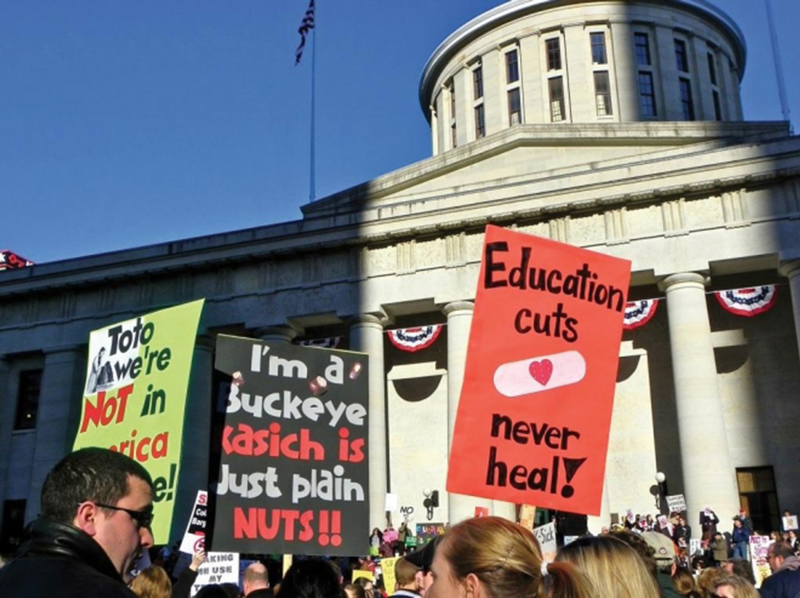Smarmy, round-shouldered and sporting a haircut that makes his head look just a little asymmetrical, Ohio Gov. John Kasich cuts a striking pose in his weekly video addresses (available at www.youtube.com/user/HouseConference). Checking these out gets you close to the Governor’s mansion in that way that Facebook gets you close to your friends — that is to say, very and not at all. And it makes me wonder, as I look at what is surely the best public face Kasich can offer, “With enemies like this, who needs friends?”
Of course, Big John has enemies. In droves. He’s got a certain clueless G.W.-style swagger that inspires disgust in his Democratic counterparts. And his iron-fisted leadership may be backfiring.
CityBeat recently caught up with Caleb Faux, executive director of the Hamilton County Democratic Party, to get his thoughts on the local political climate, and he says the governor’s push through of Senate Bill 5, which decimates union power in Ohio, may bring a swell of Democrats to the polls. Progressives will have their chance to push back by voting “No” on State Issue 2, which would repeal SB5.
“SB5 should increase turnout,” Faux says. “We could easily see 40 percent or more at the polls.”
And this could cause a ripple effect, meaning more Democratic votes for other important issues and elections. Faux says that in terms of the Cincinnati City Council election this November, the appointed incumbents are the most vulnerable.
“They have yet to prove they can win a election,” Faux says.
There are two Republicans, Amy Murray and Wayne Lippert, and one Democrat, Wendell Young, who will be on the defensive.
The axis around which these and other local races revolve is, of course, the budget.
“We’ve had the same arguments again and again,” Faux says. “Revenue has been shrinking and that requires cuts to city services.”
Realistically, he says, this has to include police and fire.
“If you don’t make cuts there you almost wipe out any other city service,” Faux says.
And local Municipal Court races present the possibility of politically balanced local courts.
“Democrats stand on the edge of having half the feet on the court,” Faux says.
Look for tight races between Democrat William Mallory Jr. and Republican incumbent David Stockdale in District 3, which leans left. Democratic candidate Matthew Fellerhoff is defending his seat on the bench in the right-leaning District 4 against Republican Megan E. Shanahan.
We Are Ohio spokesperson Melissa Fazekas says she believes her group’s campaign to repeal SB5 is building momentum. A recent Quinnipiac University poll shows support for the repeal of SB5; the July 2011 poll showed that repeal is supported by 35 percent of Republicans, 75 percent of Democrats and 52 percent of independent voters.
“Senate Bill 5 is an unfair, unsafe law that hurts us all,” Fazekas says. “It takes away worker rights and employee safety. Teachers, nurses, firefighters and police officers didn’t cause the economic mess and aren’t the enemies.”
Make or Break for Local Light Rail
November will also be a defining moment for light rail in Cincinnati. John Schneider, chairman of Cincinnati’s Alliance for Regional Transit, says the latest up/down vote on the streetcar could set the city back by a quarter century.
If voters agree to block light rail in Cincinnati, it would mean blocking all light rail for the next decade, not just the Cincinnati Streetcar.
“I’m concerned about the future of all rail in this town,” Schneider says. “I’ve been planning light rail in this town for over 15 years, and if this is put on ice for 10 years you’re going to lose a lot of institutional memory.”
He says that when voters actually read the language of the issue and understand how the conservatives who pushed it through are overreaching, they almost always oppose it. He says that the portrayal of the streetcar issue as being a way to save the city money is a red herring.
“(The 10-year duration) is so long as to go way past our current economic difficulties,” Schneider says. “It has no basis in reality. It’s a strategic move by a bunch of suburbanites who are trying to hold the city back … They’ve attempted to leverage skepticism about the streetcar into a long term, durable prohibition against spending money on any sort of rail in the city limits. Once people realize how they’ve overreached, there will be push back.”
Schneider says this conservative front against the streetcar has not been countered with enough common sense talk from the city.
“They’ve allowed opponents to portray it as something for tourists, as an amusement park ride rather than what it is,” he says. “The ballot issue is simple. Voters need to read the language of the ballot issue and read up on modern streetcars. I’m confident a person who has good will for the city of Cincinnati would vote against that language.”
Schneider says that modern streetcars have brought economic gains whenever they have been used in urban areas.
“With modern streetcars there have been no failures, ever,” he says.
These organizations will be spending the fall organizing against Kasich-endorsed policies:
We Are Ohio: bipartisan coalition organizing to repeal SB5
(www.weareohio.com)
Progress Ohio: organization currently campaigning against SB5, HB 194, Republican redistricting in Ohio and American Electric Power company’s attempt to block new EPA air pollution rules, among other progressive causes.
(www.progressohio.org)
Fair Elections Ohio: a state political action committee founded to protect Ohio’s electoral process from bureaucratic measures that may result in voter suppression; currently gathering signatures to force a vote on House Bill 194, a Republican-sponsored bill that restricts voting rights. (www.fairelectionsohio.com)



